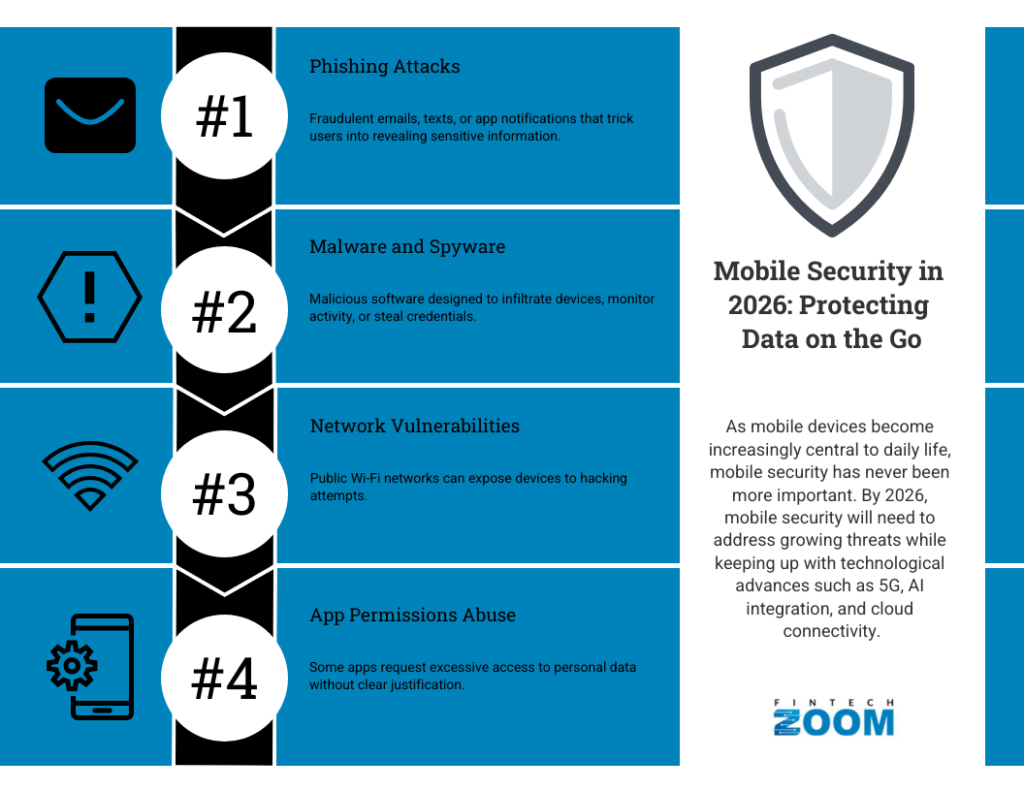As mobile devices become increasingly central to daily life, mobile security has never been more important. Smartphones and tablets handle sensitive information, from banking details and personal messages to business communications and entertainment accounts. By 2026, mobile security will need to address growing threats while keeping up with technological advances such as 5G, AI integration, and cloud connectivity.
Key Threats Facing Mobile Devices
Mobile devices face a variety of security challenges. Cybercriminals are constantly developing new methods to steal data or compromise systems. Some of the most pressing threats include:
- Phishing Attacks: Fraudulent emails, texts, or app notifications that trick users into revealing sensitive information.
- Malware and Spyware: Malicious software designed to infiltrate devices, monitor activity, or steal credentials.
- Network Vulnerabilities: Public Wi-Fi networks can expose devices to hacking attempts.
- App Permissions Abuse: Some apps request excessive access to personal data without clear justification.
These threats make it essential for users to adopt proactive security measures and stay informed about emerging risks.
Top Mobile Security Practices for 2026
Implementing effective security strategies can help protect data on the go. Key practices include:
- Regular Software Updates: Keeping the operating system and apps updated reduces vulnerabilities.
- Strong Authentication: Biometric verification and multi-factor authentication help prevent unauthorized access.
- Secure Networks: Using VPNs or trusted mobile networks mitigates risks when accessing public Wi-Fi.
- App Vetting: Download apps only from official app stores and review permissions carefully.
- Data Encryption: Encrypting sensitive files ensures that stolen data remains unreadable.
By combining these practices, users can significantly reduce the risk of mobile security breaches.

Tools and Technologies Enhancing Mobile Security
| Security Feature | Description | Benefit |
| Biometric Authentication | Fingerprint, facial recognition, or iris scanning | Prevents unauthorized device access |
| AI-Powered Threat Detection | Uses machine learning to identify suspicious activity | Provides real-time protection |
| Mobile Device Management (MDM) | Allows centralized control for personal or corporate devices | Ensures consistent security policies |
| Cloud Backup Security | Encrypts and stores data safely in the cloud | Protects against data loss from theft or damage |
| Secure Browsers and VPNs | Encrypt internet traffic | Maintains privacy while online |
These tools reflect the increasing integration of technology and security, allowing users to protect sensitive information while maintaining convenience.
Mobile Security in Entertainment and Gaming
Mobile entertainment, including streaming and online gaming, is a growing area where security is critical. With the popularity of mobile casinos, players must trust that personal and financial data is protected. Platforms optimized for mobile gaming incorporate advanced encryption and authentication methods. For example, responsible mobile gaming platforms such as https://first.com/casino/mobile provide secure environments that protect user accounts while offering seamless entertainment.
Looking Ahead
As mobile technology advances, security will need to evolve alongside new threats. AI-driven monitoring, blockchain authentication, and enhanced encryption protocols are expected to become standard in 2026. Users will benefit from more intuitive security features integrated directly into devices, making protection less burdensome without sacrificing safety.
Mobile devices will continue to play an essential role in daily life, and maintaining security will be a shared responsibility between technology developers and users. By adopting smart practices and leveraging advanced tools, individuals can enjoy the full benefits of mobile technology while keeping their data safe on the go.


